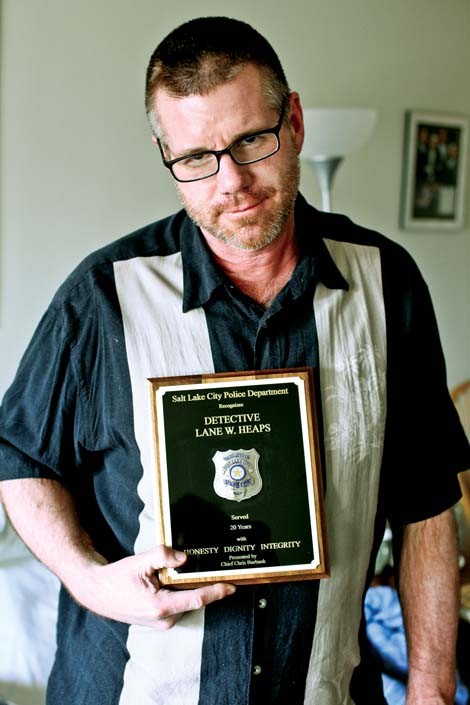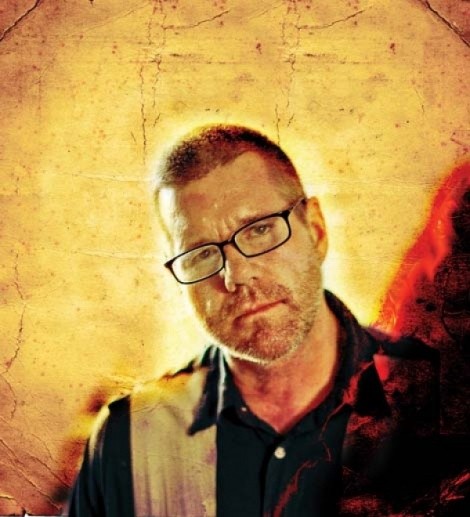Heaps slammed into a chair, his gun flying out of his hand, even as the suspect wielded a pair of scissors, cutting Heaps’ forearm and hand. As Heaps dove toward the man, the suspect retrieved the officer’s gun, and Heaps found himself staring down the black hole of his own .380. The suspect fired, the shot, Heaps says now, zipping harmlessly through his hair.
Even as he grappled with the man, he shouted out at then-fellow vice officer Shawn Josephson, “Just fucking shoot the guy.” As Heaps pulled himself up from the suspect, he saw three “perfect holes” in the man’s side, “a big hunk of his love handle on my pants.” He and the other officers watched the man “take his last five breaths.”
A man who openly admits to a hefty sense of pride, Heaps says he didn’t weep or have nightmares like some officers have after a shooting. Josephson, however, recalls that Heaps was watchful over him in the following days, concerned about his psychological well-being. “He’s a tough guy, he didn’t like to show that side of himself,” Josephson says. The night of the motel shooting, however, Heaps should have been more concerned about his own standing in the department.
Although Heaps, then an undercover vice detective, was neither the lead nor the senior officer on the attempted arrest, he was the one who led the assault after the drug dealer had fled from an undercover female officer in the middle of a drug deal. As a vice officer, his job, for the most part, was arresting prostitutes, but he had taken part in the drug bust to help out fellow officers. The two senior female officers and Josephson had only one interview each with Internal Affairs, but Heaps, by then an eight-year veteran, had five. When he questioned why so many, he was told he was the de facto leader. “They didn’t like the shooting, but they couldn’t lay anything on me technically,” he says in his growly, rasping tones.
For the first 11 years of his career, Heaps was a “street monster,” he says, a term he borrows from author Joseph Wambaugh to describe officers who are effective in a fight and typically take control of dangerous situations when other, less experienced—or, Heaps argues, incompetent—colleagues fail to do so. “Street monsters do the dirty work,” he says. His approach in his first years caused problems. He had several force complaints held up against him in 1990. But after 1990 such complaints “quit coming; he changed his way of doing business,” recalls Deputy Chief Lee Dobrowolski.
Heaps “looked like a brute, but he’s very intellectual, very eloquent,” says Dobrowolski, who for many years was Heaps’ best friend. They worked together on the graveyard shift and would park car to car and talk in the early hours about their shared passion for music and the arts. Music is a passion Heaps now explores as a volunteer blogger on CityWeekly.net. “His size intimidated a lot of people and then he spoke with a passion that intimidated them a lot more,” Dobrowolski says.
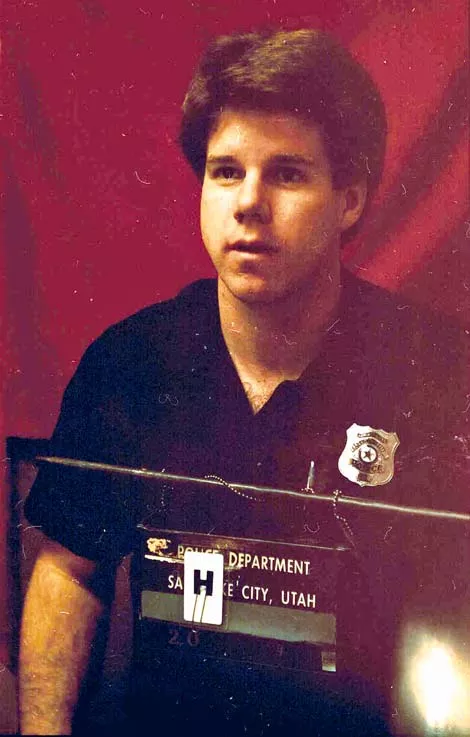
When Heaps retired from the Salt Lake City Police Department [SLCPD] on Sept. 1, 2008, he was a bitter, self-described functioning alcoholic with chronic-pain issues from a lower-spine surgery. His heavy drinking started after a year in vice. “Part of the problem with Lane was he keeps everything in,” says Sgt. Merrill Stuck, who served with Heaps on the graveyard shift for many years. Then, like many cops who struggle with witnessing trauma, “he tried to drink it away.”
Currently, Heaps takes eight medications a day and wears synthetic heroin patches that offer no euphoria. “Just half the drugs I have in me would kill the average person,” he says. Yet the pain is barely eased and every third day becomes unbearable. “When it gets too heavy, I panic, I don’t know what to do with it.” Morning or night, he self-medicates, pouring with a shaking hand tumblers of rot-gut whiskey to take the edge off the pain, his anxiety and depression. “Pain, loneliness, those scary things,” he says. “They’re all they are cracked up to be.”
He believes his spinal issues may well have stemmed from years of twisting in his patrol car to type one-fingered on the computer. But the anger that gnaws at him about his treatment by the police department, notably in his 1999 trial and subsequent acquittal for the alleged assault of a handcuffed DUI suspect in March that year, seems even more corrosive than the daily agony that keeps him awake into the early hours.
Heaps grew up steeped in the old-school police culture of his father, Willard, who rose to assistant chief of the Salt Lake City Police Department before retiring the day his son joined the force in 1988, and the memory of his uncle, Sgt. Ronald L. Heaps, who was shot to death in 1982 during a routine investigation. But in contrast to the tough-guy cops who skirt civil rights to get the bad guy in prime-time dramas like NYPD Blue and Blue Bloods, the colliding realities of urban policing and department politics ended up devouring not only Heaps’ career but his life.
Heaps’ story provides a visceral insight not only into the nature of policing Salt Lake City but also into the toll the profession exacts on some of its workers. With long-term anxiety issues, agoraphobia—a fear of being in places you can’t leave—and clinically diagnosed with post-traumatic stress disorder from his police work, Heaps, self-medicating with alcohol and copious amounts of prescription drugs, was arguably already an officer on the brink. That he also felt railroaded by the very department he had given his life to for so many years, “threw him into a horrible, wicked spiral,” SLCPD Lt. David Cracroft says, which he has yet to come out of.
Sgt. Josephson credits Heaps and another officer-cum-friend who killed himself with providing the impetus for him to set up and run a peer-support program to the department 10 years ago. It’s a need that continues to be pressing. “Everyone in law enforcement knows someone like Lane Heaps,” Dobrowolski says.
On Feb. 3, Heaps turned 50. Retired from the force, without work, he sits in a one-bedroom apartment in Murray, his back cushioned by pillows, his feet up on a stool, trying to reduce the constant “sledgehammer” burning he feels in his feet. “He’s still barely not drowning,” says SLCPD Sgt. Roslyn Rainey, his soon-to-be second ex-wife, whom he married in 1996. After all these years, he still seethes over his treatment by former superiors, who have long since moved on after sanctioning his prosecution by the District Attorney’s Office. “The motherfuckers who came after me weren’t touched, not even a little bit, making it impossible for me to heal, and leaving revenge fantasies always swirling in my head to this very fucking day,” he says. “Can you understand why I’m bitter?”
THE SMELL OF THE NIGHT
Lane’s father, Willard Heaps, now in his mid-70s, joined the Salt Lake City Police Department in 1959, when it had 350 officers. “At that time, if you were aggressive, you were at the top of the pile,” Willard says. The approach was to make criminals fear Salt Lake City Police, he continues. “It was rough and ugly, but it worked. If I stop you, I treat you like a man until you show me that you are not, then I’ll make a correction.” The administration over Willard Heaps sought officers “who took steps to get things done. People who went places were the guys who shot people.” But, he cautions, “You had to know when to slam somebody and when to back off.”
Lane Heaps joined the police on Sept. 1, 1988, the day his father retired as assistant police chief from the same department. Lane Heaps says he became a cop for the money and the health insurance. “It’s an easy job for me; I’ve never done anything better. It’s about common sense: You think quickly, coolly, and can’t pick wrong or you might be dead, in prison or have somebody else like me save your ass.”
He loved his first years, especially the summer nights on the graveyard shift, “when only the cops and the bad guys are around,” and you could get to the violence “while it’s still happening.” But he worked so many graveyard shifts, “I couldn’t smell the night anymore.” The constant barrage of negativity he experienced as a cop wore on him. “Everywhere you go, people were drunk, pissed off, fighting, you have to go in and referee that crap. After a few years, it starts to drag you down.”
The violence he saw was also difficult to absorb. A year into his service, Heaps witnessed something that he still struggles to understand. He and his partner received a call from dispatch to go to a man screaming at a small, rundown apartment complex on Park Street, close to Trolley Square. When he and his partner entered the ramshackle, “shithole apartment,” they encountered a 40-year-old woman lying on a bed, flip-flopping like a fish out of water, a wound in her head so large and deep they could see her brain. For several seconds, Heaps and his partner stood in disbelief, staring at the woman’s demise. It was something, Heaps says, “we couldn’t recognize, that simply couldn’t be. She was kind of like a zombie. It was one of the ugliest deaths I’ve ever seen.”
They took the woman’s boyfriend into custody and led the screaming man, her son, into another room. The woman had been caring for two boys, ages 6 and 8. The 8-year-old’s ear had been half-bitten off. The boy told the officers that it was the grown son who had bludgeoned his own mother, then raped her, in a fit of jealousy after she had shifted her sexual favors from him to her new boyfriend. The grown son had bitten the boy’s ear off as a threat to silence him.
Heaps witnessed “more than his fair share” of violence, Dobrowolski says. Sgt. Stuck says witnessing such crimes “really got to [Heaps].” Officers like Heaps “hold everything in, it eats away at them.”
JAWBREAKER
Violence and trauma weren’t the only problems that dogged Heaps’ early career in the department. Others would sow the seeds of his future decline. When he joined the force, he thought he was inheriting the law-enforcement culture of his father’s generation, where, Dobrowolski says, “if you took a swing at a cop, you went to the hospital” before you went to jail. “That way you wouldn’t take another.” But by the late 1980s, such acts of violence by officers were no longer tolerated. In 1990, according to Heaps’ discipline file, which City Weekly accessed through a records request, his department upheld two inappropriate force complaints against him.
One was for “slapping an arrested person while that person was handcuffed.” Heaps says after he had chased a driver up an off-ramp against traffic, got the suspect out of the car and handcuffed him, the man was verbally abusive. Heaps, his “adrenaline just everywhere,” slapped him. “You can’t do that,” he says now. “You can’t bitch slap because you are wound up.” While he says he accepted his suspension for several days without pay, he did not agree with the department’s decision over a second 1990 excessive-force complaint.
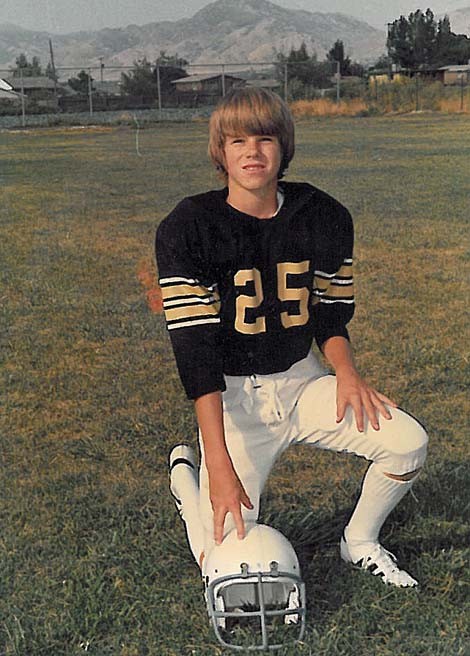
A self-described “physical wonder” who could bench press 1,000 pounds in his 20s, Heaps pulled the suspect’s arms up and the youth hit him on the side of the ear. Heaps responded by a single punch to the side of the face, knocking the youth out cold for 17 minutes and breaking his face in three places. “I was worried I had killed him.” His sergeant told him, “Lane, you’re too big to be hitting guys.” Heaps replied, “Well, Captain, give me a height-weight chart so I know when I can hit somebody.” He got five days unpaid leave “for breaking that guy’s jaw.”
PLAYING THE PART
In 1997, Heaps spent a year undercover in vice. He grew a beard, put on weight. “You’ve got to be a fat Mormon husband who wants some,” he says, when describing the ideal look for a vice undercover agent. “Driving a station wagon, with a child seat in the back and a family-home-evening manual,” rendered him, in prostitutes’ minds, a believable client. “Arresting prostitutes is twice as hard as drug dealers,” he says. “You’ve got to act. I drove around with a 16-ounce beer in my lap so I really smelled like a drunk. If half the courts saw what we did ...”
His work brought him close to four prostitutes. “I got to really like them and feel sorry for them.” Many were addicted to injecting black-tar heroin—a mix of heroin and morphine derivatives—which eats muscle and creates large abscesses on users’ arms. One he had to threaten with jail before he could persuade her to go to the hospital to treat the gaping, drug-inflicted abscesses on her arms.
His time in vice was short-lived, though, lasting only a year. Heaps, along with all the other officers involved in the fatal shooting of the alleged drug dealer at the North Temple motel, were quickly transferred to other departments, recalls Sgt. Josephson, although no reason was given as to why. Heaps went back to the graveyard shift with other officers who, like him, were known to openly question the decisions of their superiors. Heaps made enemies higher up because he wasn’t “willing to accept everything he was told,” Lt. Cracroft says, and “offended some big wheels because he opened his mouth. He wasn’t a golden child.”
His currently divorcing spouse, Sgt. Rainey, recalls a time when officers were expected to back up bounty hunters. Her husband called the watch commander seeking clarification as to why uniformed officers were effectively sanctioning a bounty hunter’s activities by backing them up. Heaps was told to “just help them out,” she recalls, but later the procedures were changed. “It didn’t earn him brownie points,” Rainey says.
STREET JUSTICE
On March 14, 1999, Heaps was called by Dobrowolski to help with an undocumented Mexican male he had detained, handcuffed and sat on the ground. Jorge Torres-Vences had run through two red lights and, Heaps later testified, appeared to be intoxicated. Dobrowolski says Heaps made a mistake in taking his eyes off of the 28-year-old suspect. When Heaps realized Torres-Vences might be trying to slip his cuffs, he bent down to get a closer look and Torres-Vences kicked him in his knee. As Heaps fell, fearing he was losing control of the situation, he says, he threw one punch to Torres-Vences’ face. The punch caused a blow-out fracture, breaking a tissue-thin bone behind the eye, which requires treatment with antibiotics.
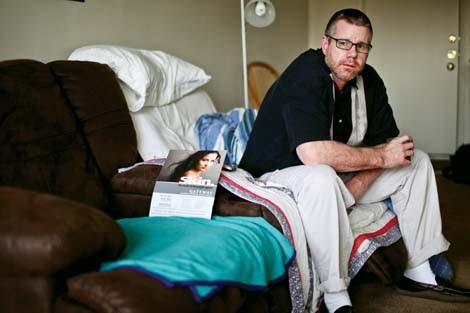
Initially, Heaps was suspended from duty. “I didn’t think then, and I don’t think now, what he did was improper, let alone illegal,” says Dobrowolski. Heaps argues his two 1990 excessive-force complaints made him a target in the eyes of superiors wanting to make an example. He sat at home, at times working out his frustrations at the gym, at others all but drowning himself in liquor. On June 5, 1999, he pleaded not guilty to a simple assault class A misdemeanor. The following month, SLCPD Chief Ruben Ortega fired him. Rainey realized for the first time, “you didn’t have to do something wrong to get into bad trouble.” She felt dazed, “like I had fallen down the rabbit hole.”
Ortega’s administration “brought out the worst in everybody, in supervisors and management,” says Lt. Cracroft. Rainey recalls that the “old-boy network” in place prior to Ortega’s arrival in 1992 evolved into a culture under the new chief where you “got ahead by crawling over somebody else.” Numerous officers interviewed for this story felt Heaps was a victim of superiors who, Cracroft says, “decided to win points [with the administration] and do payback to Lane” or his independent-minded graveyard squad. Ortega declined to comment for this story, in part because the events “were so long ago.”
As the months dragged on before his trial in November 1999, Heaps continued drinking and conjured up plans to ruin the marriages of those who had betrayed him, “plans to ruin their careers, plans to destroy their lives.” Heaps couldn’t sleep at night, Cracroft recalls. “He would visit us at the 7-Eleven,” where officers go to get coffee at the beginning of their shift. “It was horrible on Lane,” Cracroft says. “His friends were trying to put him in jail. That about killed him.” With a criminal charge pending, Heaps couldn’t find a job, despite applying for 32 positions, most of them at minimum wage. “Nobody would touch me, I was poison; scared to death, wondering how I would support my kids,” he says.
When the case went to trial, Heaps was represented by private counsel Ron Yengich. “Lane really felt that he was misused by the police department and did not get sufficient support,” Yengich wrote in an e-mail.
Heaps’ father had thought the incident would go no further than an investigation. He sat through every day of the trial. “I think the department was looking for somebody to discipline,” he says now.
The trial lasted for four days. According to a Nov. 21, 1999, story by Derek Jensen of the Deseret News, Salt Lake County prosecutor Nicholas D’Alesandro said Heaps’ punch “was street justice,” and that Torres-Vences was “as vulnerable as a person can be without any means to protect himself, lying there.” Yengich dismissed D’Alesandro’s argument as “a fable,” arguing a handcuffed man could be as dangerous as one whose hands were free. He accused Torres-Vences of being a liar, both over his denial he had been drinking and claiming memory loss as a result of Heaps’ blow. After two agonizing days of deliberation, the innocent verdict came in and the courtroom packed with blue uniforms erupted with shouts of “Yes.”
Yengich told The Salt Lake Tribune’s Stephen Hunt, “We make the police do our dirty work, and we hold them to a higher standard and expect them to be 100 percent perfect. People in uniform are human beings. To say they have to accept being assaulted … is beyond credibility.”
Afterward, Rainey recalls, “people would say ‘congratulations.’ For what? For going through hell when he didn’t do anything wrong?”
A LIFE OF PAIN
The day Ortega left office, shortly before Rocky Anderson was elected mayor, then-acting chief Mac Connole reinstated Heaps.
Willard Heaps believes the trial “destroyed [Lane’s] police life.” As Lane sits across from him in the living room of the senior Heaps’ Alpine home, several boxes of officer shields’ gleaming in the cabinets, Willard tells him, “It was like you were paralyzed.” Lane agrees. “I wasn’t one-tenth of the cop I was before. I was so worn out, so beat, I didn’t hurry to anything.”
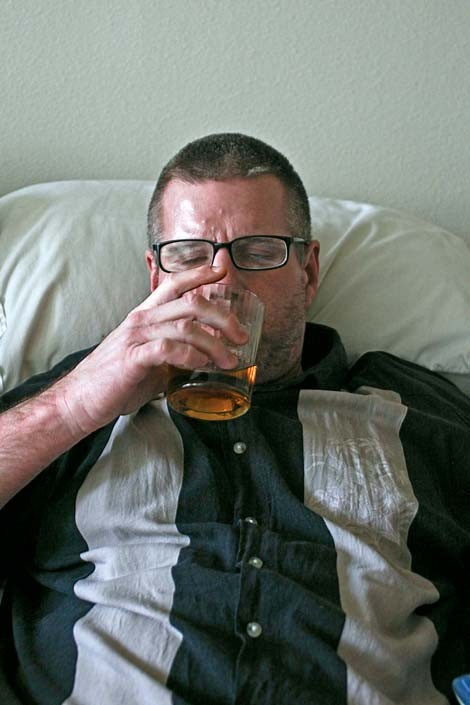
Dobrowolski wonders if Heaps would “still be with us if it wasn’t for Roslyn [Rainey],” his wife. But Rainey struggled increasingly to cope with Heaps’ demands, saying she effectively became his caretaker. “It was like he pulled me in and strangled me.” Heaps could not overcome “the sense of unfairness,” she says. “He never got payback.” If only, she says, someone on “the eighth floor said, ‘We blew that, we should have investigated, you got screwed over royally,’ it would have been different. Instead, it was, ‘here’s your job back, you should be grateful, you’re on probation.’ ”
In 2006, Heaps had an operation on his lower spine to realign a vertebra. Scar tissue buildup around the spinal cord, however, resulted in constant, chronic pain.
“I’ve never known anyone for whom things go more badly,” Rainey says.
Before Christmas 2010, Rainey asked Heaps for a divorce. “I can’t live with him,” she says. He retired with a pension of half his salary, but with no health insurance. The divorce means he will lose Rainey’s insurance. “I’m afraid of all the hoops he will have to jump through,” she says, to get the medication and help he needs, and the choices he might then make.
HOLD MY HAND
When an officer retires from the force, Dobrowolski says, “you’re on your own.” While he notes that “not all retired officers are basket cases,” that most enjoy their retirement, Heaps, for one, says he understands all too well the officers and retired cops who kill themselves. “I know six or seven suicides,” he says. He recalls a young man who had parked his car, run a hose from the exhaust to his car, and tape-recorded his last moments. “You could hear the hiss of the CO coming in. He had a surprised look on his face.”
When Heaps found himself parked in his car, waiting for hours for a final answer in the darkness, he thought about that young man. “I’ve tasted the oil on my gun barrel more times than I care to remember,” he says.
Heaps’ life goes in three-day cycles of increasing physical pain. Catch him on the wrong day, and it’s hard to imagine a man closer to the floor of despair. He can barely stand up and struggles to make coherent sentences. “Goddamn, what’s happening to me?” he mumbles. “I’m getting weak, I used to be strong.” He bangs his head against a car door to try to overcome the agony in his lower back.
He rocks back and forth, desperate, almost panicking at being unable to escape his own skin. “I don’t want to cry like a little girl,” he says.
In his Murray apartment, he half-falls, half-flops back into the easy chair where he now spends so much of his life, and drags into his arms his cat, Molly, a feral kitten he raised by feeding her with an eye-dropper, only for the animal to growl, whine and finally squirm out of his arms.
“I hope to have a natural death and run away clean,” he says. “That’s all I care about.”
He lies back and closes his eyes. As his breathing deepens and he sinks, mercifully, into the too-brief oblivion of sleep, he holds his open hand out, like a child looking for a parent’s reassuring touch.
